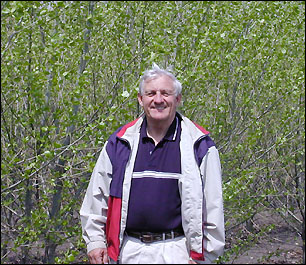Trees can be grown on CRP land
Fred Ruguske, of Willmar, has planted 1,200 acres of hybrid poplar trees south of Regal. He started over 10 years ago with an investment project in mind after attending a meeting on harvesting poplar trees for energy. "This is a good way to turn marginal farm land into good productive land," said Ruguske, who started out with most of his land enrolled in CRP. Now the majority of his trees are on land that is out of the program.
 Trees cost about ten cents each and 600 trees can be planted per acre, said Ruguske. Agroforestry requires intensive tillage and herbicide treatments for the first three to four years. After that, intensive maintenance is unnecessary unless additional fertilizer application or insect control is needed for specific sites.
Trees cost about ten cents each and 600 trees can be planted per acre, said Ruguske. Agroforestry requires intensive tillage and herbicide treatments for the first three to four years. After that, intensive maintenance is unnecessary unless additional fertilizer application or insect control is needed for specific sites.
Fred Ruguske of Wilmar has planted poplar trees on 1.200 acres of former CRP land near Regal. He sells the trees to a paper plant.
Grasslands are more costly than bare land to prepare for planting because the weeds and grass need to be killed with herbicide prior to planting. The estimated total cost of maintenance (tillage, planting, cover crop, cultivation, and herbicide/fertilizer/insecticide applications) is about $300-$400 per acre for a hybrid poplar tree plot.
Hybrid poplar trees can mature in 8-15 years and yield about 30 cords per acre from a one-time, clear-cut harvest approximately ten years after the initial planting.
Ruguske has a 12-year contract with International Paper of Sartell to harvest the trees. He is guaranteed $30 per cord.
If Ruguske could do it over, he would look over soil maps before purchasing land for hybrid poplar production. He learned from experience that not all land is ideal for agroforestry. "Where there was Osakis soil, most of the trees died off," he said.
A nonprofit organization - WesMin Resource Conservation and Development Association, in conjunction with U.S. Department of Energy - has funded $3,000 worth of test projects in this area. WesMin conducted a seven-year research project on hybrid poplar acres by Regal. The goal was to have 40 cords per acre, but the research indicated a maximum of 25-30 cords per acre as the expected yield for 10 years, with an average of only 17 cords per acre.
General sign-up for qualifying CRP land will begin again this fall, "With the new farm bill expanding we hope CRP contracts will be good," said Steve Sellnow, district conservationist with the National Conservation Resource Service (NCRS) in Stearns County.
Most CRP contracts run 10-15 years. CRP also offers continuous sign-up for land as buffer strips and living snow fences.
On CRP land, there is a 50 percent reimbursement to establish trees, explained Sellnow. In previous farm bills, to re-enroll in CRP, the landowner must own the land for at least a year and must have been cropped (soybeans, corn, etc.) for two of the five years prior to an open CRP sign-up period to qualify for the program.
Since his land is out of CRP but does not meet these requirements, Ruguske is not eligible to re-enroll his land in CRP at present. This - along with the intricacies of growing trees and the smaller than projected return - is why Ruguske does not recommend agroforestry to everyone.
Land types eligible for the fall CRP sign-up include cropland and farmed wetlands, with the payment rate based on soil types. In the past, the CRP continuous sign-up offered higher payment rates due to an additional 20 percent incentive payment. "The CRP continuous payments range from $80 to $110 (per acre) depending on the soil type and there are incentive offers," explained Rick Reimer, program coordinator with the Kandiyohi County Soil Water Conservation District.
More information will be coming out with the farm bill this fall regarding various incentive offers for several conservation programs (EQUIP, WHIP, and WRP).
"The important issue with poplar tree planting is producing wood products. This is a great renewable resource," said Reimer...
Another alternative crop that can be grown on CRP land is grapevines, he added.
"Planting trees provide excellent wildlife coverage for pheasants and deer. This area south of Regal is one of the best (for wildlife habitat) in Minnesota," said Ruguske. One downside to agroforestry, noted Reimer, is the loss of the wildlife cover when the trees are harvested.
According to a brochure from the Minnesota Department of Natural Resources (DNR), new trees can be replanted between the stumps after the stumps have been treated with herbicide. Otherwise removal and disposal of stumps can be costly and time consuming.
Markets for growing trees are pulp production, wood chips, energy (biomass to electricity), and lumber. After Ruguske harvests his trees, he plans to replant more trees of a better variety, or he could let the stumps spin off for new tree growth. Or he could plant fast-growing soybeans to cover the bare land, which, in two years, would make his land eligible for the CRP program again.
A complete source of information concerning hybrid poplar tree production is available from the University of Minnesota Extension Service at www.extension.umn.edu.
Contact the author at carlcble@lakedalelink.net • Return to News Menu
Home | Marketplace | Community